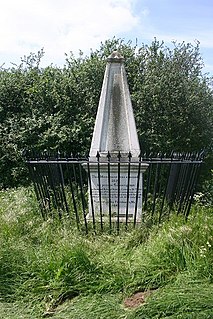
Edmund Bonner was Bishop of London from 1539 to 1549 and again from 1553 to 1559.

John Rogers was an English clergyman, Bible translator and commentator. He guided the development of the Matthew Bible in vernacular English during the reign of Henry VIII and was the first English Protestant executed as a heretic under Mary I of England, who was determined to restore Roman Catholicism.

Hugh Latimer was a Fellow of Clare College, Cambridge, and Bishop of Worcester during the Reformation, and later Church of England chaplain to King Edward VI. In 1555 under the Catholic Queen Mary I he was burned at the stake, becoming one of the three Oxford Martyrs of Anglicanism.

William Hunter was a Marian martyr burnt to death in Brentwood, England at the age of 19 on 26 March 1555, on Ingrave Road. He had lost his job in London as a silk-weaver because he refused to attend the Catholic mass, despite an order that everyone in the City of London had to attend, and had come to live with his parents in Brentwood, but got into a dispute when discovered reading the Bible for himself in Brentwood Chapel. He refused to accept the Catholic dogma of transubstantiation according to which the bread and wine of the communion become the body and blood of Jesus.

Rowland Taylor was an English Protestant martyr during the Marian Persecutions.
The Ipswich Martyrs were nine people burnt at the stake for their Lollard or Protestant beliefs around 1515-1558. The executions were mainly carried out in the centre of Ipswich, Suffolk on The Cornhill, the square in front of Ipswich Town Hall. At that time the remains of the medieval church of St Mildred were used for the town's Moot Hall. Later, in 1644 Widow Lackland was executed on the same site on the orders of Matthew Hopkins, the notorious Witchfinder General.
Nicholas Shaxton was an English Reformer and Bishop of Salisbury.

John Bradford (1510–1555) was an English Reformer, prebendary of St. Paul's, and martyr. He was imprisoned in the Tower of London for alleged crimes against Queen Mary I. He was burned at the stake on 1 July 1555.

The Oxford Martyrs were Protestants tried for heresy in 1555 and burnt at the stake in Oxford, England, for their religious beliefs and teachings, during the Marian persecution in England.

Thomas Harding was a sixteenth-century English religious dissident who, while waiting to be burnt at the stake as a Lollard in 1532, was struck on the head by a spectator with one of the pieces of firewood, which killed him instantly.

Walter Milne, also recorded as Mill or Myln, was the last Protestant martyr to be burned in Scotland before the Scottish Reformation changed the country from Catholic to Presbyterian.

George Marsh was an English Protestant martyr who died in Boughton, Chester, on 24 April 1555 as a result of the Marian Persecutions carried out against Protestant Reformers and other dissenters during the reign of Mary I of England. His death is recorded in Foxe's Book of Martyrs.

Agnes Prest was a Cornish Protestant martyr from the reign of the Catholic Queen Mary. She was burned at the stake at Southernhay in Exeter in 1557.

Thomas Hawkes was an English protestant martyr who burned to death in 1555 during the Marian Persecutions rather than allow his son to be baptised into the Roman Catholic Church.

Thomas Benet from Cambridge, was an English Protestant martyr during the reign of King Henry VIII. In 1524, he moved to Torrington, North Devon, with his wife and family so that he could exercise his religious conscience more freely in a county where no one knew him. He was executed by burning on 15 January 1531, for heresy, at Livery Dole outside Exeter in Devon, under the supervision of Sir Thomas Dennis (c.1477-1561) of Holcombe Burnell, near Exeter, then Sheriff of Devon.

The Colchester Martyrs were 16th-century English Protestant martyrs. They were executed for heresy in Colchester, Essex, during the reigns of Henry VIII and Mary I. Their story is recorded in Foxe's Book of Martyrs.
The Canterbury Martyrs were 16th-century English Protestant martyrs. They were executed for heresy in Canterbury, Kent, and were the last Protestants burnt during the reign of Mary I. Their story is recorded in Foxe's Book of Martyrs.
Bartholomew or Bartlet Green, was an English Protestant.

The Stratford Martyrs were eleven men and two women who were burned at the stake together for their Protestant beliefs, either at Stratford-le-Bow, Middlesex or Stratford, Essex, both near London, on 27 June 1556 during the Marian persecutions.















